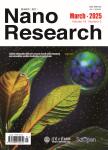Quick photofabrication of functional nanospheres from de novo designed peptides for NIR fluorescence and MR imaging
作者机构:School of Pharmaceutical SciencesCapital Medical UniversityBeijing 100069China Key Laboratory of Photochemical Conversion and Optoelectronic MaterialsTechnical Institute of Physics and ChemistryChinese Academy of SciencesBeijing 100190China
出 版 物:《Nano Research》 (纳米研究(英文版))
年 卷 期:2023年第16卷第3期
页 面:4029-4038页
核心收录:
学科分类:080901[工学-物理电子学] 0809[工学-电子科学与技术(可授工学、理学学位)] 08[工学] 080401[工学-精密仪器及机械] 0804[工学-仪器科学与技术] 0803[工学-光学工程]
基 金:supported by Beijing Natural Science Foundation(No.2222051) the National Natural Science Foundation of China(No.81973442)
主 题:synthetic peptide photocrosslinking de novo design encapsulable nanosphere imaging nanoprobe dityrosine
摘 要:Combining the noncovalent and covalent interactions,a series of peptide amphiphiles were designed de novo and synthesized to architect functional assemblies by means of *** strand of peptide sequence was structurally capped with photoactive tyrosine-tyrosine(YY)motifs at both termini,and the spacing was filled by alternating of hydrophilic D(L-aspartate)and hydrophobic X(ε-aminocaproic acid)*** visible-light irradiation,these de novo designed peptides underwent rapid photocrosslinking within merely 10 ***,the modulation of alternating D-X pairs in occupying spacer would adjust molecular amphiphilicity,regulate charge distribution,and control particle size and loading capacity of peptide nanospheres(PNS)in aqueous *** entirely peptide-based matrix,this PNS system could host cationic indicators of fluorescent rhodamine and magnetic GdIII for exemplar near infrared(NIR)fluorescence and magnetic resonance(MR)imaging,which paves a pathway to biomaterial and biomedical applications using de novo designed peptides.




